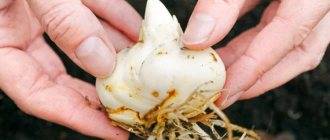Plants » Flowers
3
1200
Article rating
Kira Stoletova
One of the most important stages in growing flowers is replanting. This procedure is carried out with the aim of replacing the soil, improving the quality of flowering and rejecting rotten, shriveled bulbs from healthy and strong ones. Transplanting tulips is a simple procedure, but it requires some knowledge and skills from the grower.
Terms and rules for transplanting tulips
Why do you need to replant tulips?
It is recommended to replant the bulbs of species tulips annually, especially for double varieties. Ordinary representatives of the species, without transplantation and loss of decorative qualities, grow in one place for no more than 3 years. The procedure can prevent the degeneration of the variety.
Without long-term transplantation, the tulip bulb becomes overgrown with numerous children, which impair the access of nutrients to it; it is important to promptly separate new roots and plant them separately
The dug up roots are sorted, sorted, the largest ones, without signs of infection, are selected for replanting in the spring, and the children are separated from the mother bulbs for their further germination. Planting material is also treated with fungicides to prevent infection by fungi.
The soil in the flower garden sags significantly under the influence of precipitation; if the tulips are not replanted, the roots deepen, and the flowering of the crop becomes sparse and short-lived.
The reason for replanting tulips in the spring may be if they change for the worse. If flowering becomes sparse and short-lived, the stem and leaves become twisted, the flowers are moved to a new location.
Possible problems
After transplantation, tulips may be more susceptible to various diseases. This is most often due to the presence of an infected bulb or virus in a new flower bed. The following diseases may appear:
Gray rot. It appears most often if after planting the holes are watered very often or there is rainy weather for a long time. Symptoms: plaque and damage to foliage and stems. To prevent it, it is necessary to spray the bushes with Bordeaux mixture.
Soft rot. It affects plant bulbs and manifests itself as soft and watery roots. To prevent this, it is necessary to add wood ash to the soil and etch the soil with a weak solution of manganese.
A common disease is the variegation virus. Externally, it can be distinguished by characteristic changes in the color of the bud. The disease cannot be treated; the plant must be removed.
Tulips are a decoration for almost every garden plot. Proper care and timely transplantation of bulbs will preserve the characteristics of the plant for a long time.
When to replant tulips: in spring or autumn
The timing of tulip transplantation is influenced by a number of factors.
Among them:
- climatic and weather features of the region;
- plant development phase;
- characteristics of a particular variety (in particular, early or late flowering).
The general ideal option is usually considered to be an autumn transplant, which is carried out at least 30-40 days before the predicted first snow. In central Russia this is usually the period from the first ten days of September to mid-October. For northern regions with early winters, the optimal timing is usually limited to mid or late September.
The possibility of transplanting tulips in the spring is determined by the following rule: the soil temperature at a depth of 10 cm should be + 8-9 °C. In temperate regions this is around mid-March and early April. In the northern regions, suitable conditions can be expected longer, until the beginning of May.
It is not allowed to transplant during the following periods:
- Just before flowering. If at this stage the plant needs to spend additional effort on rooting, this can lead to its weakening and general deterioration of its condition. It is best to wait until the tulips have bloomed.
- Late autumn, at the stage of the onset of severe frosts. The bulbs will not have enough time to properly prepare for wintering in the ground and the risk of their death will greatly increase.
How to replant a blooming tulip
It is highly not recommended to transplant tulips during flowering. Such a plant will be much more difficult to take root in a new place. In addition, interfering with the natural development cycle of the bulb can negatively affect the formation of sprouts and flowering next year.
Important! Varietal tulips are especially difficult to tolerate transplanting during this period.
If there is still a need to replant a flowering plant, it is recommended to act according to one of the following scenarios:
- Remove the tulip from the soil along with the bulb. Carefully rinse it from the ground without cutting off the head, place it in water and wait until the plant blooms. After this, air dry the bulb and store it until a convenient time for planting in the ground arrives.
- Carefully dig up the plant along with a large lump of earth using a garden fork or bayonet shovel. Transfer to a new, previously prepared place, and water generously.
Blooming tulips do not tolerate transplantation very well, so it is best to wait until they bloom
After flowering
Tulips usually fade by summer. The replanting period after flowering falls in September. Moreover, this option is ideal, since this period is considered the most gentle for plants. The first bulbs can be dug up already in mid-July. At this time, their scales become a characteristic light brown shade. This moment should not be missed, as the plant takes new roots very quickly. In this form, replanting tulips is much more difficult.
The bulbs removed from the ground are left to dry either in the open air or indoors. At the beginning of autumn they are cleared of husks and existing stems. Make a weak solution of potassium permanganate in a separate container. Flower bulbs should be kept in this solution for some time. This procedure will protect the plant from diseases and pests in the future. All that remains is to dry the bulbs again and plant them in open ground.
You should pay close attention to the landing site. The plot of land or flowerbed should be located on a windless area, but with direct and abundant access to sunlight. Before planting, the soil needs to be additionally fertilized. Autumn is considered the ideal time to transplant tulips.
How to prepare a bulb for transplantation
To transplant tulips in the spring, planned in advance, the material is prepared in the summer. After waiting until the end of June or the beginning of July, when flowering ends and the leaves and scales of the bulb turn yellow, the plants are dug out of the ground. Then they are cleaned of adhering soil, dried in a warm room for 3-4 weeks and sorted by size, discarding damaged or rotten specimens.
After this, the bulbs are wrapped in paper with holes for aeration and stored in the vegetable compartment of the refrigerator. In the spring, a couple of weeks before the planned transplant, they are placed in wide boxes or containers filled with about 15 cm of nutrient soil. The bulbs are carefully laid out at a distance of 4-5 cm from each other, sprinkled with a 5 cm thick layer of earth and watered. 2 weeks after the sprouts appear, the tulips are transplanted into open ground. With this approach, plants do not require long-term adaptation; they will actively develop and flowering will begin on time.
Sometimes there is a need to urgently replant tulips; this can be caused by pests or depleted soil. In this case, it is not advisable to dig up the bulbs one at a time, but it is better to move them to a new place along with a lump of earth on the roots.
It is most convenient to replant already rooted tulips in the spring, moving them to another place along with a large lump of earth on the roots
How to prepare the soil for replanting
The site for transplanting tulips is selected according to the following criteria:
- well lit by the sun;
- protected from wind and drafts;
- with light, nutritious, neutral, well-drained soil.
It is important that the bed does not become flooded after the snow melts. Ideally, it should be located on a small hill (if necessary, you can add a little soil).
Advice! A few days before transplanting tulips, it is recommended to carefully dig and loosen the soil in the garden bed. This will saturate it with air and promote good rooting of plants.
During the digging process, organic matter (humus or chopped grass) is added to the soil. If the acidity of the soil is high, ash will help reduce its level. If the soil is clayey or too heavy, it won’t hurt to dilute it with coarse river sand. If necessary, you can enrich the soil with minerals (compositions containing nitrogen, phosphorus, potassium).
Rules for replanting tulips
Tulips need to be transplanted to a new place once every 3-4 years. If this is not done, the bulbs will begin to grow, forming “babies”. This will have a bad effect on flowering, the plants will begin to lag in growth and gradually lose their inherent beauty.
If spring replanting is planned in advance, it is best to pre-germinate the bulbs in a container indoors
Transplanting tulips in spring has its own characteristics. It is advisable to adhere to certain rules:
- It is recommended to transplant tulips in sunny, dry, windless weather.
- Mother bulbs and “children” separated from them are best placed in separate beds, since the latter will definitely not bloom this year, since they need to grow up.
- You need to dig grooves or separate holes in the soil. Their depth should approximately correspond to the three sizes of bulbs that are planned to be planted. The distance between the holes should be 10-15 cm.
- Before transplanting tulips, you should water the holes with water and wait until it is absorbed into the soil.
- The bulbs need to be carefully placed in holes or grooves with the “tails” up. Large specimens are planted one at a time, small ones can be planted in several pieces (from 5 to 7).
- Sprinkle the bulbs with soil and gently water with warm water.
- Level the soil in the garden bed.
Warning! It is not advisable to transplant tulips into an area where nightshade or other bulbous crops previously grew.
Spring planting
Transplanting in the spring, of course, is not the most desirable, but when there is no way out or the circumstances are so, it is important to know how to do it correctly. So, first you need to select the most beautiful and healthy bulbs and plant them in a container with prepared soil. Choose the container very carefully: its depth should not exceed 15 cm. It is better to carry out the transplantation process by the end of April.
You can replant tulips in the spring
When planting bulbs, try to maintain a minimum distance of 3 cm between them. After planting, be sure to sprinkle them with a few centimeters of soil and water them carefully. When the first shoots appear, you can plant the plant in open ground.
Advice. If the tulips have already begun to bloom, it is not advisable to replant them, since many varietal plants react quite sharply to this process. If the circumstances are this way, then try to act as carefully as possible: dig up each flower with a large lump of earth, carefully move it to a new place. Fill the holes with soil without compacting it. Water lightly.
Autumn planting
As for autumn planting, as mentioned earlier, this is the most gentle option for tulips. So, start replanting approximately by mid-July. At this point, the scales on the bulbs will turn brownish. Try not to be late, otherwise the plant will begin to take root, and then the replanting process will become much more difficult. Leave the dug up bulbs to dry either in the fresh air or in a well-ventilated area.
Tulip bulbs
At the beginning of autumn, dry bulbs must be thoroughly cleaned of husks and dry stems, kept in weak potassium permanganate to protect them from pests and diseases, dried and planted in the ground.
Remember, the area for transplantation should be virtually windless and sufficiently lit. The soil must be fertilized on the eve of planting.
That, in principle, is all you need to know about the intricacies of transplanting tulips to a new place. Good luck!
Digging up the bulbs
Many gardeners make a serious mistake - they start replanting tulips immediately after digging them up. The tubers remain in the soil all summer. It would be correct if you leave the plants until the deciduous part dries out by 2/3. After which the planting material is dug up and stored in boxes for several months. And when autumn comes, they are transplanted to a new place.
Drying
The dug up bulbs are cleaned of old scales and roots, and the children are also separated. Planting material is sorted by variety and placed in boxes. It is not advisable to cover them. Until September, the indoor temperature should be up to +20 degrees. A few weeks before landing, it is lowered to +15 degrees.
Once every few weeks it is worth inspecting the bulbs. If they show signs of damage, for example, mold or rot, then such specimens are separated from healthy ones. Mold is wiped off with a dry cloth and then treated with a fungicide solution. If the rot is small, it is cut off and the cut area is treated with brilliant green. If the tuber is severely damaged, it is thrown away.
Pre-planting treatment of bulbs
Immediately before planting in a permanent place, the planting material is treated in a weak solution of potassium permanganate. The bulbs are immersed in water for 30 minutes. After which they are dried and transplanted to a new place. Before planting in a new place, it is worth preparing the soil. The soil is dug up to a depth of 20 cm. Then the soil is watered with a solution of potassium permanganate to disinfect it.
Biological features of culture
When growing tulips, summer residents sometimes cannot achieve good results. The crop often gets sick, the stems grow unevenly, are twisted, and the flowers do not have a standard size. To avoid failures, you need to know about the main components of a tulip:
- The root system of a flower develops from the embryonic root of the seed, and the remaining roots extend from the lower part of the bottom of the bulb and are called adventitious. A lot of such appendages are formed, but they die off every year.
- The bulb is the main part of the plant. It collects the nutrients the flower needs, it is the reproductive organ from which the stem, leaves and flower grow annually. The scales covering the bulb perform storage and protective functions.
- The stem is erect, strong, stretches upward and bears a colorful single flower.
- The plant has few leaves. They start at the base of the aerial part, grow to mid-length and form a green surrounding.
- Annual flower. It has six falling leaves. It stands out for its richness of shapes and variety of shades.
- The fruits complete the life cycle of the flower. Each nest of the triangular box contains small seeds - the future of the tulip.
Reasons for moving to another place
The dream of any summer resident is colorful spring flowers in a flowerbed, but before you start growing, you need to figure out why the crop is being replanted. Transplanting tulips is a necessary undertaking. Plants can bloom in one place for up to four years, but every year the flowers become smaller and lose their color.
There are plenty of reasons for replanting tulips; sometimes the plants themselves indicate the need for replanting:
- This often manifests itself in the absence of flowers.
- Sometimes tulips bloom at the right time, but the stems take on twisted shapes.
- Plants grow and feel uncomfortable in a dense flowerbed.
- Bulbs are transplanted for preventive purposes. Such measures prevent the appearance of parasitic insects.
- If the area is not changed for a long time, the plants begin to hurt. Only healthy bulbs are selected for replanting.
Is it possible to replant blooming tulips?
It is not recommended to replant specimens preparing for flowering or flowering, but if an emergency arises, this should be done very carefully and carefully. It is better to dig up plants when the sprouts have not had time to grow, before the buds appear
They need to be removed with their roots, the shovel inserted into the soil as deep as possible and scoop up more soil. But practitioners argue that it is better to cancel such a risky undertaking and postpone it until the autumn season.
Further care of plants
After an autumn transplant, sprouts appear in the spring, after the snow melts. Depending on the region, this may be the end of March-April. In May, plants are already blooming in most areas.
Plant care:
- If mulch was added to the flowerbed in the fall, it is immediately removed so that the soil warms up faster in the sun.
- After the seedlings appear, the soil around them is carefully loosened.
- Until the buds begin to appear, it is not advisable to water the flowerbed frequently; abundant irrigation is carried out after the plant enters the flowering phase.
- Fertilizers are applied to the soil only in the first half of the season, when the plants are just beginning to actively grow (you can apply any fertilizers for flower crops).
When applying fertilizing, it is worth monitoring the external condition of the flowers. If you overfeed tulips, they will begin to actively increase their leaf mass and stretch upward. Nutrients are added no more than 2-3 times per flowering season.
Top dressing
Basic care for this flower involves regular feeding.
After the sprouts appear, the soil is fertilized with nitrogen-containing preparations, which promote intensive growth of shoots and leaves.
Before flowering, it is not necessary to fertilize tulips, although some gardeners apply complex mineral fertilizers once.
Re-feeding with nitrogen and phosphorus-potassium preparations is carried out during the budding period. The last feeding of decorative flowers is done after the end of flowering - phosphorus and potassium are added to increase the immunity and winter hardiness of plants.
In autumn, beds with bulbous ornamental crops should be covered with burlap, hay or film. You should take care of covering material in advance: there is no guarantee that frosts will not occur earlier than predicted. In the spring, it is also advisable to use it when there is a sudden drop in temperature, which often happens even in the middle zone, not to mention the northern regions.
Before replanting in the fall, the soil is mulched. In spring, the plants are practically not watered until the buds appear. Tulips will only need the moisture that remains in the soil after the snow melts. As soon as the flowers appear, pay attention to their appearance - deformed specimens with signs of degeneracy of the variety should be dug up and destroyed. With further transplantation they will degrade even more. The soil around the entrances should be loosened to provide oxygen access to the roots.
Do not water tulips immediately after transplanting
The beauty and advantage of early flowers
As soon as the snow melts from the garden plots, primroses begin to hatch from the ground, which include primroses, irises, daffodils, and of course, everyone’s favorite tulips. It is impossible to imagine a spring flower garden without these beautiful flowers, which delight the eye with a variety of colors, long-lasting flowering and brightness.
There are so many varieties that exist today, and all of them can feel great in the conditions of central Russia, of course, subject to proper care.
The advantage of these plants is that after flowering has ended and the bulbs have been dug up, any other flowers related to annual crops can be planted in this area. Thus, the flowering in the flowerbed will not be interrupted, and the garden will be transformed into a new quality.
Many gardeners do exactly this: they plant annual seedlings immediately after digging the soil after removing the tulip bulbs from it.
Storing and preparing tulips for planting
To achieve abundant flowering of tulips the next year after digging up their tubers, a number of necessary preparatory works should be carried out:
- Free the bulbs from soil and husks.
- Discard diseased and damaged plants.
- Separate the daughter small bulbs from the mother bulbs.
- Sort the tubers for future planting by size.
- Carry out disinfection in a solution of potassium permanganate (per 10 liters of water - 1 g of powder).
- Dry well in a dark, ventilated area.
- Provide storage until autumn in a dry, warm place.
In autumn, a place for flowers is selected. It should be elevated and not floodable during spring snowmelt.
The soil is fertilized with ash, mown grass, humus and dug up. With well-fertilized soil, plants can be planted in the same place.
Before planting, grooves up to 10 cm deep are made in the prepared beds. The distance between them should be at least 13-15 cm.
At the right time, the tubers are planted in the ground and sprinkled. Experienced gardeners advise planting small bulbs first and only a week later planting large ones. This should ensure friendly shoots in the spring. From frost, the top of the bed can be covered with dead wood, fallen leaves or dry grass.
If everything is done correctly, then in the spring, immediately after the snow melts and the earth warms up with the sun's rays, identical tulip sprouts will appear, which will delight you with beautiful selected flowers in the future.
Why is the time to dig up tulip bulbs right after flowering?
Over the course of even one season, tulip bulbs most often go deeper into the ground, and if they are not removed from there every year, they will go further and further.
As a result, they will sink to such a depth from which it will be impossible for shoots to break through to the top. The bulbs will likely die, leaving the spring flower bed bare. Another reason for digging up the seeds is that while the bulbs are resting, they need to create another flower stalk. The main condition is that the storage temperature must be at least 25 degrees Celsius. However, in the ground, especially in the northern regions, the temperature will be much lower than required.
This is why you need to remove tulips from the ground after they bloom: this will help avoid the death of the bulbs, as well as control the temperature of their storage and the formation of a new inflorescence.
Experienced flower growers know that in order to admire beautiful tulips in the spring, you need to take care of the bulbs of these flowers every year. This is the key point in growing tulips.
If the bulbs are left in the ground, they are crushed, and many children are formed around them, which will also grow by spring, preventing each other from receiving adequate nutrition for development. The result will be a lot of low-growing small flowers, which will degenerate every year and will not decorate the flowerbed, but will only spoil its appearance. In addition, bulbs in the ground can become sick and may bloom later than expected.
A new flower arrow after the plant blooms will form better if you do not allow the flower box to ripen by cutting off the flower stalks in time.
Some gardeners place tulip bulbs in special bulb planting baskets. This device makes it difficult to deepen the tubers into the ground. However, baskets will not protect the bulbs from being crushed and overgrown by children, which will ultimately destroy the plant. However, plastic baskets make the task of removing the bulbs from the ground much easier.
How to preserve bulbs before planting
After excavation, the necessary requirements for temperature, humidity and ventilation of the room for storing planting material should be strictly observed.
It is important to preserve the bulbs until autumn
Particular attention should be paid to maintaining temperature conditions. This is very important for the further full development of the plant.
Basic mistakes
Below are examples of the most common mistakes made when replanting tulips.
Timely familiarization will prevent their recurrence and ensure the safety of the plants being grown:
- Carrying out transplantation during the growing season. Even if this procedure is urgently required for objective reasons, it is necessary to wait until the end of this period, otherwise the plants may not be able to transfer to a new location.
- Transplantation is carried out directly during flowering. This not only negatively affects the condition of tulips and worsens their adaptation to a new place, but also disrupts the natural development cycle of plants. Even if the bulbs survive the winter without problems, they may not bloom the next season.
- Removing the flower if for some reason the bulb was removed from the ground along with the blooming tulip. To minimize harm, it is necessary to place it in an aquatic environment and wait until flowering finishes naturally.
- Storing bulbs before transplanting at temperatures above +30 °C. Such conditions are considered unacceptable, since they often lead to the complete loss of flower buds.
Tips for subsequent transplants
- If the bulbs dug up for transplantation are slightly trimmed with a shovel, then the damaged areas can be covered with activated carbon.
- Slightly rotten specimens can also be saved: you need to carefully cut out the damaged tissue, place the tulip in a solution of potassium permanganate for half an hour, remove it, dry it, and lubricate it with a disinfectant.
- Before planting, it is useful to keep the bulbs in quarantine for a month, for which they can be placed in a plastic bag along with crushed garlic cloves. In this way, flowers can be protected from diseases and pests.
- Stepchild bulbs are planted separately, as they will not bloom for another year.
- It is worth marking the transplant site so that you know exactly where the flowers are now and do not forget about them.
When transplanting tulips into flower beds, varieties with large flowers should be placed in the middle, with small ones - along the edges, so that they are not blocked by other crops
- Do not use the growing season to change the soil. Tulips during this period are very sensitive to various changes and may die.
- It is necessary to choose a place for transplanting plants on the sunny side. However, when planting plants, it is recommended to avoid prolonged contact of sunlight with the bulbs, otherwise the tulips may be damaged and not take root.
- Large and medium-sized bulbs must be replanted in different places, since their flowering times may differ.
- When using several varieties of tulips, it is necessary to maintain some gaps between the beds to avoid degeneration of the variety.
Let's celebrate! Tulips are one of the earliest flowers; proper plant transplantation and care will allow you to get bright and large flowers that will delight others for a long time. Also, following the rules of care will preserve the plant variety and prevent the formation of diseases.
Some useful tips will help many gardeners avoid unpleasant consequences when transplanting these flowers:
- If you decide to replant tulips in early spring, then the planting material must be placed in a container with cool soil and placed in a basement or cellar for several weeks. This stratification procedure will increase the survival rate of tubers in open ground after planting.
- If possible, drying the bulbs before transplanting should be done outside, but without direct sunlight.
- During the transplantation process, adult tubers should be sorted from their children and planted in different places, since their flowering periods are also different.
- Tulips can be dug up and planted along the daffodils. These flowers grow very well and go together very well. Tulips bloom immediately after the daffodils fade.
Deadlines
It is recommended to dig up tubers when the plant has finished flowering and the leaves and stems have turned yellow. There are many varieties of tulips, differing from each other in the appearance of the flower and the timing of flowering. Early varieties bloom already at the end of April, so preparations for the next season in the form of digging up tubers can begin at the end of May. Tulip bulbs of mid-early varieties are dug up in June, and late ones - in early July.
The timing of planting bulbs in the ground depends on weather conditions and the area where the flower grows.
Some gardeners practice replanting in early spring. However, in this case you should not hope for flowering this season.
Also, if necessary, you can replant the tulip during the active flowering phase. In this case, it will not be possible to preserve the buds and flowers.
Let's sum it up
When growing tulips in the garden, you cannot do without replanting. Without this procedure, the plants will die in a maximum of 3-4 years. It is recommended to do it at least once every two years, and even when the tulips clearly need it, as evidenced by the unsatisfactory appearance of the flowers. The bulbous crop should not be replanted during the flowering period and in the summer; this should be done in spring or autumn.
The choice of the most favorable period depends on many factors, and primarily on the climatic characteristics of the region. Both spring and autumn transplants have their advantages and disadvantages. The latter can be neutralized if you follow the rules and recommendations of specialists.
Sources
- https://u-florista.ru/tyulpan/mozhno-li-peresazhivat-tyulpany-do-tsveteniya-vesnoy.html
- https://fermilon.ru/tsvety/odnoletniki/mozhno-li-peresazhivat-tyulpany-vesnoy-do-tsveteniya.html
- https://gruppa-pm.ru/kogda-nuzhno-peresadit-tyulpany/
- https://sad24.ru/cvety/mnogoletnie/kogda-mozhno-peresadit-tyulpany.html
- https://DachaMechty.ru/tsvety/tyulpan/peresadka-osenyu.html
- https://zen.yandex.ru/media/id/5c169e6f87f1e000ac197a44/5cde975339169100b31a089b
- https://greensotka.ru/lukovichnye/kogda-peresazhivat-tyulpany.html
- https://vogorode.com/flowers/mnogoletnie/peresazhivat-tyulpany.html
[collapse]











